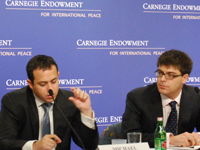Registration
You will receive an email confirming your registration.
The United States is currently undertaking a root and branch review of its nuclear posture. In a speech before the UN General Assembly on September 23, President Obama pledged this Nuclear Posture Review would open “the door to deeper cuts, and reduce the role of nuclear weapons” in American defense policy. In addressing how to achieve this goal in practice, Michael Gerson from the Center for Naval Analyses argued that the United States should pledge not to use nuclear weapons except in response to a nuclear attack. Dr. Jeffrey Lewis from the New America Foundation suggested that enhanced consultation was a more effective way of reassuring allies than maintaining obsolete nuclear capabilities.
No First-Use
Today, the United States maintains a posture of calculated ambiguity, that is, it does not rule out a nuclear response to a non-nuclear attack. Gerson highlighted three factors in advocating a move to a no first-use pledge:
- First, improvements in conventional weaponry have eliminated many of the uses for nuclear weapons identified during the Cold War and echoed in previous Nuclear Posture Reviews, most notably responding to conventional aggression. Conventional weapons such as precision-guided missiles, argued Gerson, are “safer, they cause less collateral damage, they provide more flexibility, there’s less risk of escalation, and perhaps most importantly, they’re highly credible.”
- Second, Gerson argued that, if the threat to use nuclear weapons first is at all credible, then it is also dangerous destabilizing. Specifically, a state with a vulnerable nuclear arsenal, fearing a preemptive American nuclear attack, could decide to launch a nuclear attack against the U.S. in a crisis. Removing this temptation by adopting a no first-use pledge would make America safer.
- Third, if the threat of nuclear first-use is not credible then keeping open the option does not enhance U.S. security. In contrast, a no first-use pledge, by devaluing nuclear weapons, would help U.S. nonproliferation efforts.
In discussion with the audience, it was suggested that the United States might want to retain a posture of calculated ambiguity in order to keep open the option of a pre-emptive nuclear strike against enemy nuclear forces that were about to launch. As well as questioning whether the President could ever be sufficiently confident of enemy intentions to launch such a first strike, Gerson argued that the real problem was not destroying enemy weapons but locating them. As an example he noted that, at the start of the 1991 Gulf War, the United States launched approximately 15,000 sorties against mobile and fixed Scud launchers in Iraq. According to the Gulf War Air power survey there was not a single confirmed kill of a mobile launcher.
Also during the discussion, moderator James Acton added that, while the nonproliferation benefits of a no first-use pledge have been discussed recently by several prominent experts, there has been less discussion of its military advantages (in particular mitigating crisis instability).
Reassuring Japan with Words, Not Capabilities
The bipartisan Congressional Commission on the Strategic Posture of the United States suggested in its report released earlier this year that reductions in the size and role of its nuclear arsenal could potentially hinder the United States’ ability to assure its allies, particularly Japan, of the United States’ ability to deter attacks against them. The Commission’s report stated that the United States’ extended deterrence policy in Asia “relies heavily” on the deployment of the nuclear-armed Tomahawk Land Attack Missile (TLAM/N), which is slated for retirement in 2013. The report strongly implied that if the missile were retired, Japan would lose confidence in the United States’ commitment to its security.
Lewis argued that Japan’s anxiety fundamentally stems not from a concern over some particular nuclear-weapon system, but from a lack control over its own security. Allies that rely on the U.S. nuclear arsenal to deter potential enemies, tend to fixate on the provision of particular weapons as symbols of or “proxies” for the United States’ commitment to their defense. Rather than maintaining TLAM/N (which the U.S. navy wants to scrap), Lewis called for intensification of diplomatic efforts in the form of ongoing consultations. He said that “our goal with the Japanese should not be short-term hardware solutions but…a long-term effort to build the same kinds of consultations that we have with members of the NATO Nuclear Planning group.”
Lewis advocated a similar consultative approach with other countries protected by extended deterrence. Rather than focusing on military technologies and capabilities as symbols or “tokens” of the United States’ commitment to its allies, Lewis called for a renewed focus on “shared values and interests” and emphasis of the “indivisibility of our security.”
Tactical Nuclear Weapons in Europe
Lewis also expressed concern over “a few hundred [U.S.] nuclear weapons at airbases in five [NATO] countries.” He warned about the risk of having to remove these weapons hastily. If a problem arises with their security, for example, the public backlash would limit the ability of the United States and its allies to remove tactical nuclear weapons from Europe in an organized and careful manner. This kind of scramble could be very damaging to U.S. efforts to reassure its allies.
In light of the ongoing NATO strategic review, Lewis recommended examining “the role of nuclear weapons within NATO security.” He suggested that, as a first step, NATO nuclear weapons should be “immediately consolidated…to two sites, preferably U.S. airbases where the United States provides security.”
